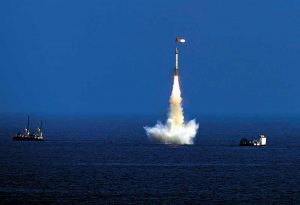Newspaper Article 29/07/2015

(By Suleman Yousaf – Intern at Islamabad Policy Research Institute)
K-15 Sagarika (Oceanic in Sanskrit) is India’s first two stage solid fuelled nuclear capable submarine launched ballistic missile system, which was developed with the assistance of Russian Federation. The New York Times had reported on 27 April 1998 that Russia is helping India to develop Sea launch ballistic missile that can carry a nuclear warhead and can strike deep inside Pakistan.
India had decided to have a second strike capability to counter Pakistan; fortunately Sagarika is Pakistan-specific missile system which is capable of hitting Sind, Baluchistan and Southern Punjab. It can only target countries in South Asian Region including Pakistan and can target some parts of Nepal as well if fired from Bay of Bengal, but China is beyond Sagarika missile’s range.
India had already developed Arihant class nuclear powered ballistic missile submarine (SSBN), this submarine will carry 12 nuclear tipped Sagarika SLBM systems. Sagarika has a length of 10.8 meters (35.424 feet), with a diameter of 0.8 meters (2.624 feet) and a launch weight in between 5,500-6,300 kg. It is capable of carrying 500-800 kg nuclear as well as conventional warheads at a striking distance of 700 kms. Another source claims the range of Sagarika between 700-1,500 kms and is capable of carrying up to 1000kg warhead.
Sagarika missile first test flight took place in February 2008 from submerged barge with a range of 750kms. In July 2009 India had integrated the Sagarika SLBM with Arihant nuclear powered ballistic missile submarine (SSBN) during sea trials. Arihant SSBN will carry 12 K-15 or 4 K-4 nuclear tipped ballistic missile, it also carries ant-ship missiles and torpedoes. This missile had already been tested more than 10 times and the production of Sagarika missile has started in 2012. In future India might replace Sagarika missile with much longer range K-4 submarine launched ballistic missile (SLBM) with a range of 3500 km that can strike any place in Pakistan and all parts of China.
Shourya is a quasi-ballistic missile system; it is a K-15 landbased hypersonic missile and which is capable of hitting targets at 700-1900km. Shourya missile can carry one ton nuclear warhead with a range of over 750 km and can strike within 20-30 meters of its target. Shourya missile has the same characteristics as Sagarika missile has but only difference is that it is transported by mobile launcher and can also be fired from underground silos.
Shourya re-entry varies from 180kg-1000kg, but it depends on range similarly if Shourya missile has a range of 750km it will carry 1000kg warhead and if the range increases to 1900km than the payload will decrease to 180kg. Shourya Re-entry vehicle has three options (i) Mark-4 RV, (ii) Mark-5 RV and (iii) Mark-6 RV both of these re-entry vehicles carry different warheads, Mark-4 carries lighter warhead of 17kt while Mark-5 and 6 carries heavier warhead in between 50-200kt.
K-15 missile system is a Pakistan’s specific missile; this system if deployed by Indian Strategic Force Command can threaten Pakistani major cities including Lahore, Islamabad even Peshawar and also if Sagarika missile is fired from Indian SSBN it can threaten entire Pakistan except for northern areas. If we compare South Asia with Cold War period in terms missile launch warning system developed by Soviet Union and United States which could detect and give a warning time of 15-25 minutes, which was enough time to give a decision against incoming missiles. India-Pakistan has little time to act against incoming ballistic or cruise missile having supersonic and hypersonic speeds. So far non among K-15 missile series is operational with Indian military.
Pakistan needs early warning and defense systems to gather information on K-15 missile pre-launch track and destroy it during crisis situation with India. Pakistan already has AWACS system that can that can be used to track enemy movements inside the enemy territory as well as on while communicating with Pakistan Navy warships and maritime patrol aircraft deployed at sea like deployment of strategic missiles especially Shourya missile on land and Sagarika SLBM deployed on Indian SSBN.
Pakistan needs complete ABM system to counter India’s land and sea-based K-15 missile system; so far Pakistan does not have any anti-missile system to counter India’s growing land attack missile systems. Major problem which South Asia faces flight time of missile systems which varies from 2-13 minutes is far shorter than missile flight time between Russia and United States. Both India and Pakistan share 3000 km long border and major cities including Lahore and Amritsar are only tens of kms away from the border.
Islamabad is located less than 100 kms away from the border and New Delhi is also less than 400 from Indo-Pak border. It means that Shourya /K-15 land based missile will have flight time of 8-11 minutes if fired from places like New Delhi, Mumbai or Agra airbase to target Pakistani cities or military airbases.
Pakistan’s only option is to buy anti-missile systems from both Russia and China including the Russia’s latest S-400 and S-500 missile system and Chinese FT-2000 air defense system. These weapon systems should be deployed in those areas which are vulnerable to any incoming aircraft or missile attack coming from Indian Territory.
Published by Frontier Post on July 24, 2015
Link of the Article: http://epaper.thefrontierpost.com/article/320794//
Disclaimer: Views expressed are of the writer and are not necessarily reflective of IPRI policy.
